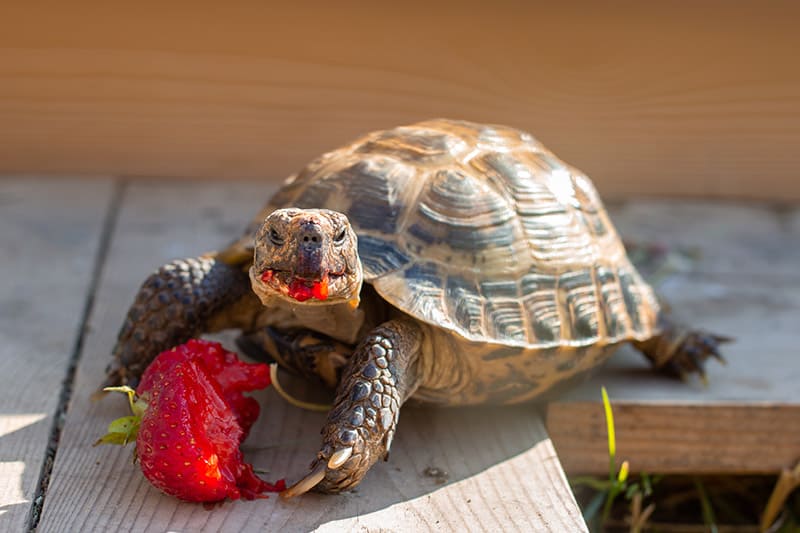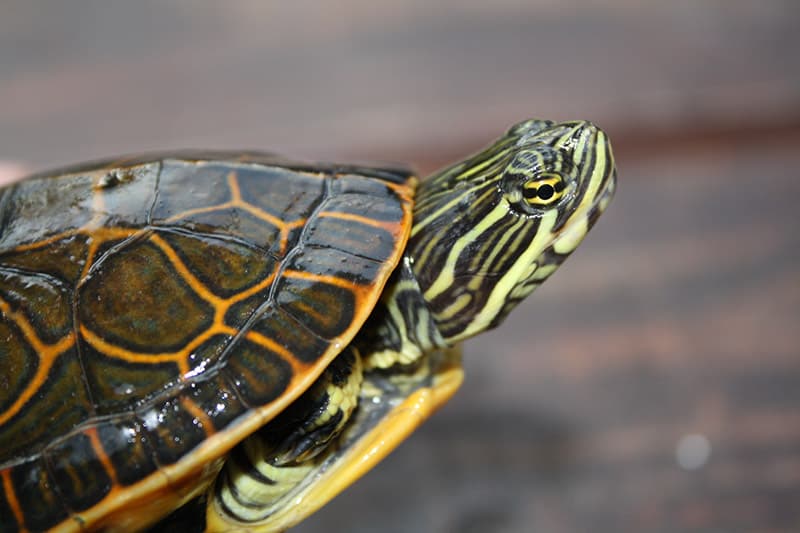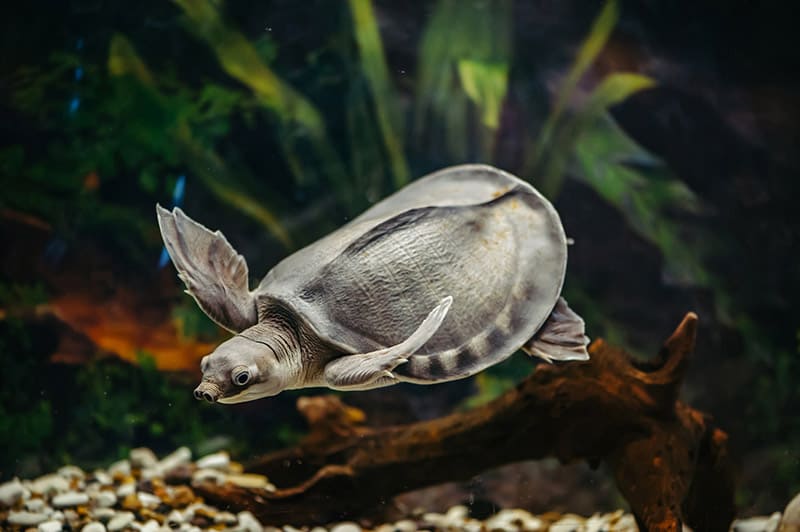Turtles and tortoises…what the heck are they? Well… Turtles and tortoises are reptiles with rather round hard shells (generally hard), four legs and a tail. They all have scales, lay eggs, and their body heat is regulated by their environment or ectothermic.
They belong to the taxanomical order Testudines, in the sub-group Chelonia (also referred to as the ‘crown group’). Scientists call them chelonians. In this order there are 13 families with over 250 distinct species. Chelonians are found all over the globe except in Antarctica. They inhabit the oceans, rivers, and lakes as well as marshes, forests, grasslands, and deserts. About 50 species are generally kept as pets.
- For information on Box Turtles, See: Guide to a Happy, Healthy Box Turtle
Why turtles and tortoises make good pets!
With few exceptions, Chelonians make harmless and appealing pets. They adapt well in captivity and with proper care can live a long time. They have fewer health problems than the average cat or dog and can be quite lively, colorful, and attractive. They display intelligence, recognizing their keepers and knowing when it’s feeding time.
Some are easier to keep and more readily available than others. Most of those commonly sold in pet stores are fairly inexpensive and require simple care.
Choose a beginner type to start with. A water turtle or box turtle make a good starter pet. Once you’ve learned about them and cared for them, you will find them to be amazing pets. As your skills and knowledge increase you will gain an even greater appreciation of these incredible animals, and may wish to explore keeping the more advanced Chelonians.

Availability
Beginner turtles are generally available and fairly inexpensive. You can buy turtles at a pet store or from a breeder. They are also available at reptile shows and on the internet.
See information on the availability of each type of species below under: Types of turtles and tortoises
Check with your local authority as you may need authorization to collect or keep some species, or you may not be able to at all. Some endangered or threatened species require special permits.
Characteristics
Many characteristics of turtles and tortoises are very species dependent.
- Shell size can range from about 3 inches (7.6 cm), the Bog Turtle Clammy Mullen, up to about 8 feet (2.4 meters) the Leatherback Turtle.
- They can be quite light, about 5 ounces (142 grams) for the Speckled Cape Tortoise, or very heavy for the Leatherback Turtle at up to 1,800 pounds (817 kilograms).
- They mature between 5 to 25 years, will lay anywhere from a few or over 100 eggs, and their hatchlings will be from 1 to 3 inches (25 to 76 ml)
- Though all turtles and tortoises are quite long lived, the aquatic species can live up to 70 years while some of the land tortoises can live 150 years or more.
It is nearly impossible to sex turtles or tortoises until they begin to reach sexual maturity. The bottom shell (plastron) of the male in some species will be indented (concave). This is especially true on terrestrial turtles and tortoises, but doesn’t always appear on the aquatic turtles. On many species of aquatic turtles the male’s foreclaws will become very long. On all species the males will have much thicker and longer tails and the vent will be closer to the edge of the shell, while the females vent will be more inside from the shell’s edge.
The natural habitats of many turtles and tortoises are being destroyed or encumbered with modern developments, some are being wiped out by disease, and others are inadvertently being captured and removed from their homes. Consequently many are becoming threatened. There are 49 species that are currently listed as endangered or vulnerable.

Social Behaviors
There are some personality characteristics that are common to all turtles and tortoises. They are quiet, shy, and harmless yet display intelligence. They can identify their keepers and know when it’s feeding time.
Turtles and tortoises are very sensitive to loud noises, vibrations, and sudden bright lights. Move slowly around them as they can be quick to frighten if they feel threatened. If frightened, most will withdraw their head, legs, and tail into their shells; though aquatic turtles will first try to swim quickly away. Those with less shell have developed other defense mechanisms; like the snappers who have an extremely strong mouth, the musk turtles which can emit a rather distasteful odor, and some that have strong claws or extreme agility. Once they have withdrawn, they are often very slow to re-emerge.
Turtles and tortoises are quite happy and content being kept as a single pet. Though most species can usually be kept together, there can be territorial tension, especially when in breeding mode. This is most apparent when different species are kept together. Some tortoises have been known to ram and even kill other tortoise species.
Always wash your hands before and after handling!
How to Choose Your turtle or tortoise
When deciding which turtle or tortoise is for you, keep the following basic considerations in mind:
- How much do you want to spend?
- How much space do you have for it?
- How hardy is it and how easy is it to care for?
- What color, shape and size do you want and is that turtle or tortoise readily available?
- Another very important consideration in choosing a turtle or tortoise involves the type of environment it needs. See also: Guide to a Happy, Healthy Box Turtle
To pick a healthy turtle or tortoise, here are some things to look for:
- Make sure the eyes are bright and clear, no discharge or encrustations.
- Make sure the eyelids are not swollen or puffy.
- Listen to it’s breathing, no wheezing or bubbles coming from the nostrils.
- Avoid those that are gasping with an open mouth
- The turtle should not be listless, its limbs should be working.
- Make sure the limbs are not dangling or weak when you pick it up.
- Make sure the limbs don’t look thin and spindly.
- Look for any open, unhealed wounds on the soft areas of the turtle.
- For aquatic turtles, release it in the water. It should submerge rapidly and it shouldn’t swim with one side higher than the other.
- The shell should be firm unless it is a soft-shell turtle (leathery shell) or a hatchling.
- Cracks and pits are not necessarily an indication of anything wrong, but be sure to check them to make sure there is not any type of infection or unhealed wounds.
Many turtles and tortoises are protected so check with authorities in your area on laws governing your selection.

Types of turtles and tortoises
The more common terms, turtle and tortoise, are generally used as a way to describe Chelonians based largely on the types of habitats in which they are found.
- To see different types of turtles visit: Water Turtles and Semi-terrestrial Turtles (Box Turtles)
Water Turtles (turtle):
Turtles, which spend a good deal of time in the water, usually have webbed feet for swimming. Most live in freshwater, but there are a few that are from brackish habitats. These are mostly considered aquatic turtles or semi-aquatic (marsh and swamp type) turtles. This consists of about 150 species.
Though they can be harder to keep clean than land turtles, they are often easier to care for. There are several species that make good pets for, both for beginners and more advanced keepers, and these turtles are generally inexpensive. Some of these include the Red-eared sliders and other sliders and cooters, Painted Turtles, Map Turtles, Reeves Turtles, and Stink-pots.
In the water turtle group there are basking types and non-basking types:
NOTE: Water Turtles are best kept by older children and adults that are able to provide responsible care. Aquatic turtles, especially the sliders and cooters, are notorious as carriers of the salmonella bacteria which can be transmitted to humans and a potential health hazard. Red-eared slider hatchlings use to be a popular first pet for children. Due to the potential health hazard, in the mid 1970’s the sale of turtles under 4″ (10 cm) as pets has been discontinued in the United States. The larger size would hopefully discourage small children from putting the turtles in their mouths. But because unwashed fingers in the mouth after handling a turtle can still cause possible contamination, both children and adults need to practice safe hygiene. Wash your hands both before you handle a turtle (you can pass pathogens to turtles) AND after you handle a turtle to prevent possible contamination! |
Box Turtles – Semi-terrestrial Turtles (sometimes called – terrapin):
Semi-terrestrial turtles spend time both in the water and on the land, and always live close to water. The term terrapin is derived from the word terrapene, which means ‘land turtle’.
Though a bit more care intensive than the water turtles, there are several land turtles that can make good pets. Several fairly inexpensive land turtles such as box turtles, are readily available at pet stores and are great for beginners. The American Box Turtles are a very good choice, as are the Malayan Box Turtle and the North American Wood Turtle.
Other land turtles (and most of the tortoises) are pets for a more advanced keeper. These more specialized turtles are offered at reptile shows or through breeders, and can be quite expensive.
|
Tortoises (tortoise)
Tortoises are exclusively land bound. With only a couple exceptions they have highly domed shells. The burrowing species have spade-like flattened front feet. They are quite ackward swimmers, and if they get in water that is too deep they can easily drown.
- To see different types of tortoises visit: Tortoises
Some tortoises can get very big and will need a large environment, often with very specific temperature and humidity requirements. They are subject to more serious health problems than land turtles and many are endangered. They are very long lived and often will reproduce in captivity.
Tortoises are recommended only for an experience keeper, as they can have very specific temperature and humidity requirements. They are best kept by specialists. They are offered at reptile shows or through breeders, and can be moderately priced or extremely expensive.
|

Housing & Care
Knowing what type of turtle or tortoise you have will help you determine what type of housing your pet will need to keep it happy and healthy. Your pet’s housing is also what provides its sense of security. Be sure to also check the page describing your particular turtle or tortoise for more in depth information on its specific needs.
Each turtle or tortoise has a specific type of environment that it needs. There are basically three habitat types:
Water Turtles: Aquatic and Semi-aquatic turtles.
Those that are closely tied to the water which includes the aquatic turtles and also some of the semi-aquatic turtles. These turtles have a long history of being kept as successful pets.
- Aquatic turtles kept indoors are most commonly housed in an aquarium. Outdoor housing is usually seasonal, used during the warmer months, and is generally some type of pond. These turtles produce a lot of waste so their water will need to be heavily filtered. Basking types will need a large smooth rock or a partially submerged log to climb on and ‘sun’ themselves. The non-basking types will simply float at the top of the water, but also like to climb on floating vegetation to bask.
- Semi-aquatic turtles can also be housed in an aquarium but will need more land than water. This can be accomplished in a variety of ways, but a common method is to provide a water dish in one corner of an aquarium or a terrarium that is firmly anchored to the bottom. They can climb in and soak and then climb back out again.
Because they need a larger land area, there are many types of enclosures that can be used, as long as they are provided with a water area. They can also be kept outdoors, again usually seasonally.
Land turtles and tortoises
Those that live mostly on land which includes all the tortoises and many of the land turtles, box turtles.
- Land turtles require less equipment and it is easier to maintain a clean terrarium than an aquarium. These turtles also seldom carry diseases that can be passed to humans.
- Land turtles are often set up in terrariums rather than aquariums, because the bulk of their environment does not need to be water. They will need access to clean water in a spill proof water dish. They can also be kept in an outdoor enclosure. For more information on keeping land turtles see: Guide to a Happy, Healthy Box Turtle
- Tortoises need almost the same type of enclosure as the land turtles but even drier conditions, similar to the desert type of box turtle. They too will need access to clean water in a spill proof water dish. They can also be kept in an outdoor enclosure. An outdoor enclosure not only reduces the maintenance workload but allows for plenty of room, which is important for larger tortoises.
Sea turtles
Those that live in the sea. There are about 8 species of sea turtle. These are not a consideration as a pet, because for the most part keeping them is illegal.
Heating and lighting
All turtles and tortoises thermoregulate their body temperature by sunning themselves. You will need to provide a source of heat and light for both turtles and tortoises. This helps not only to stimulate them to eat, but also provides the necessary external heat for thermoregulation. A general rule of thumb is that Chelonians will be most content in daytime temperatures between 75 – 85° F (24 – 29° C) and a brightly lit hot spot for basking.
For aquatic turtles, you can use a submersible heater if there is enough water or an undertank heater. Use a thermometer to measure the water temperature. For all types or turtles and tortoises provide an incandescent bulb mounted about 12 – 18″ (30 – 45 cm) above the basking area. This heat source needs to maintain the basking area at about 88 – 94° F (31 – 24° C). If you are housing your turtles indoors then you should also provide full-spectrum lighting. Outdoor environments can eliminate the need for artificial lighting and heat requirements.
Shelter
Besides needing adequate light and heat to warm themselves, all turtles and tortoises need a cool secluded area to sleep. They will also use this area if they are getting to warm. Aquatic turtles often sleep submerged, but near to the surface around twigs or vegetation. Semi-aquatic turtles will sleep burrowed into grassy areas or a sphagnum moss substrate. Land turtles and tortoises will do well with a small shed or bushy area.
Diet:
Water: All turtles and tortoises need readily available clean water.
- Aquatic turtles can dehydrate if kept out of the water for too long. They need to be able to fully submerge themselves, and many must be submerged in order to swallow their food.
- Semi-aquatic turtles need to occasionally get wet all over, but won’t spend all their time in the water.
- Tortoises and land turtles need a spill proof water dish available.
Food: Daily feedings not only take care of the immediate energy needs of turtles and tortoises, but provide for their long term health. You can tell if your pet is hungry, because it will be acting restless, moving around nosing things. If a chelonian goes too long without nourishment it can become quite weak. If it gets too weak, it will loose all interest in eating and it can be difficult to get it to start eating again.
- Aquatic turtles diet varies as an adult from what it eats as a juvenile. As a juvenile it will eat vegetable matter, but also insects and worms. As an adult it becomes primarily a vegetarian, eating dark green leafy plants.
- Land turtles are omnivorous their whole life, eating many kinds of vegetables and fruits as well as earthworms and even occasional bits of dog food.
- Tortoises are primarily vegetarians, but they do enjoy a wide variety of vegetables and some fruits.
Featured Image Credit: Debbz87, Shutterstock
